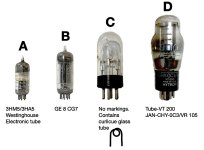I would like to cut open these old vacuum tubes to use the glass bulb and a few of the parts. Er....I actually already cut one open and became concerned about the dangerous elements that may be used in these tubes. Questions: 1) is it just to dangerous to open these and use the parts? 2) Is there a safe way to minimize the exposure to the dangerous elements used in them?
Attachments
As a curious kid, I opened and tore apart many tubes.
I also played with mercury back then.
It hasn't, hasn't, hasn't affected me as far as I know, know, know.
The first rule of bad substances is do not breathe, do not touch the substance, then touch something else, like food.
C. Is a flash tube. A Noble Gas, Xenon perhaps.
D. Is a gas regulator tube; A noble gas, probably Argon. Perhaps the cathode is coated with a toxic material, I do not know.
I put those on amplifiers, and power them, just to make that pretty colored glow.
A and B probably have strontium or barium coatings on the cathodes. Don't put them in your Tea cup; don't lick your fingers.
I once was preparing some Jalapeño peppers. I used my fingers.
Then my eyelid itched so I scratched it. Oh My!
Lesson learned.
I also played with mercury back then.
It hasn't, hasn't, hasn't affected me as far as I know, know, know.
The first rule of bad substances is do not breathe, do not touch the substance, then touch something else, like food.
C. Is a flash tube. A Noble Gas, Xenon perhaps.
D. Is a gas regulator tube; A noble gas, probably Argon. Perhaps the cathode is coated with a toxic material, I do not know.
I put those on amplifiers, and power them, just to make that pretty colored glow.
A and B probably have strontium or barium coatings on the cathodes. Don't put them in your Tea cup; don't lick your fingers.
I once was preparing some Jalapeño peppers. I used my fingers.
Then my eyelid itched so I scratched it. Oh My!
Lesson learned.
Yeah... Note to self: Remove contact lenses BEFORE enjoying habanero 'suicide' chicken wings...I once was preparing some Jalapeño peppers. I used my fingers.
Then my eyelid itched so I scratched it. Oh My!
Tom
I think it was only some special mil spec VR tubes that used miniscule amounts of radioactive materials to make sure they would ignite properly in complete darkness.
The book I once read about glow discharge tubes gave me the impression it was standard practice. In any case, out of the four 85A2 voltage reference tubes from different brands I once measured in darkness, only one needed seconds to ignite. (Due to cosmic radiation, they always ignite eventually.)
Last edited:
Dont drink beer and help wrap bacon around jalapenos
at a Bar B Que.
The bathroom trip will be memorable.
Far as what chemicals to expect in a tube
likely research chemicals used for tube getter
Barium Oxide is only one I can think of
off the top of my head.
Many more as mentioned
When working with neon many years ago.
The glass blowers didnt like or refused to rework
most beer sign glass. Usually full of phosphorus powder.
technically a argon tube not neon, mercury is added
as well for argon. unless you want very dim blue
in clear glass.
Not sure if you plan on trying to rework/ reheat the glass.
likely bad idea
at a Bar B Que.
The bathroom trip will be memorable.
Far as what chemicals to expect in a tube
likely research chemicals used for tube getter
Barium Oxide is only one I can think of
off the top of my head.
Many more as mentioned
When working with neon many years ago.
The glass blowers didnt like or refused to rework
most beer sign glass. Usually full of phosphorus powder.
technically a argon tube not neon, mercury is added
as well for argon. unless you want very dim blue
in clear glass.
Not sure if you plan on trying to rework/ reheat the glass.
likely bad idea
The radioactive gas was krypton 85 and there's only a little of it. If it's present, the data sheet will specify equal striking voltages in the dark or in light. Guidance used to be that if these devices were broken, it should be done in the open air, and that you shouldn't breathe above the breakage. There were a very few other valves containing radioactive materials, but they usually carried a warning trefoil.
Thoriated tungsten isn't really a problem because thorium's half-life is so long that it's a poor emitter. If you buy a camping gas lamp, its mantle (that glows yellow) is the same thoriated tungsten.
Probably the most common hazard is the oxide coated cathode (barium, strontium) because it easily produces a fine dust. The earlier cautions about eating, drinking, and breathing apply.
However, according to Deketh, some valves improved their heater-cathode insulation by employing beryllia. That's very nasty stuff and highly carcinogenic if you inhale its dust. I definitely wouldn't open one of those.
Mercury vapour rectifiers should very definitely not be broken open. They need very careful disposal.
Everything we do carries a hazard, so we carry out a cost/benefit analysis. I ride a motorcycle. Pushed up against my favourite body parts is a two gallon tank full of highly inflammable fluid, but it rarely proves to be dangerous, so it's allowed because of the benefit. So, I'd say, "You need a good reason to open up a valve and there are some known hazards. Probably best not to bother."
Thoriated tungsten isn't really a problem because thorium's half-life is so long that it's a poor emitter. If you buy a camping gas lamp, its mantle (that glows yellow) is the same thoriated tungsten.
Probably the most common hazard is the oxide coated cathode (barium, strontium) because it easily produces a fine dust. The earlier cautions about eating, drinking, and breathing apply.
However, according to Deketh, some valves improved their heater-cathode insulation by employing beryllia. That's very nasty stuff and highly carcinogenic if you inhale its dust. I definitely wouldn't open one of those.
Mercury vapour rectifiers should very definitely not be broken open. They need very careful disposal.
Everything we do carries a hazard, so we carry out a cost/benefit analysis. I ride a motorcycle. Pushed up against my favourite body parts is a two gallon tank full of highly inflammable fluid, but it rarely proves to be dangerous, so it's allowed because of the benefit. So, I'd say, "You need a good reason to open up a valve and there are some known hazards. Probably best not to bother."
That. Only once.The bathroom trip will be memorable
Personally, I'd leave the valves alone but it all depends on your attitude to risk. And age of course, some of this stuff can take decades to have an effect.
Like the gas masks I had as a kid. We didn't know then about the asbestos in the filters and even if we did, we didn't know about asbestosis.
Or indeed the mercury baths I made for my DIY pickup arm...
- Home
- Amplifiers
- Tubes / Valves
- Dangerous to cut these tubes open?

